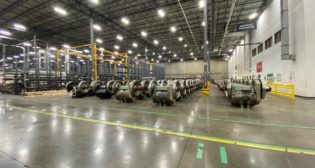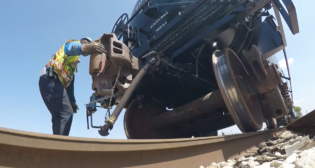
Freight car forecast: Wait till 2015
Written by William C. Vantuono, Editor-in-Chief“The most dynamic element in the long term railcar environment will be tank cars to transport ever increasing volumes of oil and petroleum products,” EPA says. “Beginning in 2015, annual railcar assemblies will stay in the narrow range of 65,000 to 67,000 cars and platforms out to the year 2018.”
EPA’s analysis of the freight car market indicates overall production figures skewed by “explosive growth” in tank car building, and a sluggish economy that will hopefully begin to gain momentum in late 2014:
“Freight car orders in the first quarter were more than double the previous quarter’s level and 91.6% above the first quarter of 2012. While this is a significant increase, a closer inspection of the data indicates that tank car orders continue to dominate the railcar environment. In the fourth quarter of last year, tank cars accounted for 61.8% of the total orders and this share jumped to 80.6% in this year’s opening quarter. And, with the railroads making significant investments in facilities and equipment to accommodate the rapid expansion of oil production, we expect tank car demand to remain on a high note for the foreseeable future.
“With regard to other car types, we continue to be concerned about the underwhelming growth of the economy as manufacturers, oil and gas producers, and coal companies struggle with the increasing number of government regulations that are dampening our economic potential. We have noticed our GDP growth has dipped from 3.1% growth in the third quarter of last year to only 0.4% growth in the fourth quarter. Hopefully, our economy can eventually embark on a stronger path of growth that will improve railroad traffic, revenue, and investments, leading to continued healthy growth in railcar demand.
“Assuming no further jolts to our economy from either EPA regulations or the Administration or external negative developments involving the financial environments abroad, we look for a stabilization in demand for most car types with the exceptions of small-cube covered hoppers, grain cars, mill gondolas, and coal cars. However, this stabilization will be at relatively modest levels. The slowing in factory output and demand for steel will moderate the growth in GB gondolas. After a strong influx of small cube covered hoppers the past two years, recent orders patterns indicate that this car type is entering a digestive phase before rebounding once again. Accordingly, we have sharply lowered assemblies of small cube equipment from 13,781 units last year to 3,000 cars this year.
“Coal cars continue to be plagued by stringent EPA standards and are certain to experience a weak 2013 before showing signs of a modest improvement in 2014. After 6,492 coal cars were assembled last year, we look for deliveries of only 2,500 units this year. In spite of declines in agricultural products and coal, the Class I railroads reported strong revenues and profits in the first quarter. The roads also continue to mention investments in track, facilities, and equipment. The solid income base of the railroads should serve to support rail car demand in the years to come. Nonetheless, the extremely weak grain and coal environments in 2012 have overcome strong growth in segments such as petroleum, motor vehicles, aggregates, and lumber.
“Due to the large volume of coal and grain movements relative to total commodity haulings, rail commodity movements dropped 3.1% last year. Nonetheless, the roads are indicating strong capital spending plans for 2013 as they prepare for continued growth in oil, chemical, light vehicle, and intermodal movements. And, the investments will be well founded as we witness future growth in these categories.
“In the light vehicle sector, we are already noting the moderation in North American light vehicle production. Last year, U.S. assemblies of light vehicles were 19.0% above the previous year while Canadian production advanced 15.3% and Mexican output expanded 12.3%. However, in the first quarter of this year, U.S. auto production increased only 2.7%, Canadian output declined 9.3%, and Mexican assemblies were up 1.3%. And, automotive haulings are reflecting the moderation in North American production. In the first quarter, rail movements of motor vehicles and parts were up only 2.1%. This will dampen growth for auto rack carriers and auto service boxcars. We look for only moderate quarterly advances in factory output through 2013 and into 2014.
“Consumer spending will be sluggish, the job markets are weak, confidence has dropped, and consumers are looking to improve their balance sheets, rather than purchase more products. The export markets have slowed considerably over the past year and we expect further weakening in 2013, before there is some bounce back in global economic activities in 2014. And, the steel markets are reflecting a slowing in industrial activities. According to the American Iron and Steel Institute, domestic steel shipments in the first two months were running 7.4% below the previous year while steel shipments were 7.6% lower in the first two months. This will dampen demand for mill gondolas this year.
“Grain loadings tumbled 9.5% last year, as the severe drought took its toll on grain production. And, based on data and information from the USDA, we expect further weakness in grain haulings this year. Domestic markets will be relatively flat while the export markets for corn and soybeans will be softer than last year. In this year’s first quarter, carloadings of grain were running 15.9% below last year. Hopefully, more moderate weather during the remainder of this year will help minimize the decline in haulings and lead to a rebound in 2014. However, we currently expect a 9.0% decline in rail grain movements this year and a modest 1.6% rebound in 2014. This will serve to moderate demand for mid-sized covered hoppers while small cube covered hopper demand declines as the strong deliveries of this equipment in the past two years are digested.
“Based on current backlogs and first quarter assemblies, we expect deliveries of 50,500 railcars this year, which represents a 14.2% decline from the 2012 level. Next year, we look for a rebound to 62,300 deliveries as our economy shows somewhat stronger growth and some aging equipment is replaced. Longer term, we are hopeful that stronger economic activities will provide support for certain railcar assemblies, while an improvement in the financial environment, high gasoline prices, and strong government backing stimulate greater demand for ethanol and DDG cars.
“Replacement pressures and technological advances as well as legislative measures will also play a role in promoting the demand for a variety of railcars. Construction activities are expected to continue to advance, which should support movements of aggregates and structural steel products. Continued expansion in demand for crude oil, petroleum products, chemicals, and food and beverages will prop up the haulings of a variety of liquid products and the demand for tank cars. Stricter air emission standards will promote the use of lower sulphur western coal, which should lead to some limited replacements of older, smaller, steel bodied coal cars with the larger volume aluminum gondolas and hoppers of today and tomorrow.
“At the same time, eastern coal fleet requirements will stimulate some demand for technologically advanced steel and hybrid coal cars. Growing worldwide nutritional needs and expanding exports will pressure the current grain service cars as we proceed through the longer term while long neglected segments such as equipment to haul waste, aggregates, and limestone show signs of revival and should add to the railcar delivery mix in the years to come.”



